Backstage in WinUI Ribbon (SfRibbon)
19 Oct 202224 minutes to read
The RibbonBackstage allows to host any controls to create a custom view, based on the requirements of the application and it can be added by using the Backstage property. Backstage appears as the first tab in the top left corner named File and opens a backstage view while clicking the File menu button.
<ribbon:SfRibbon x:Name="ribbon" BackstageMenuButtonContent="File">
<ribbon:SfRibbon.Tabs>
// Add ribbon tabs here...
</ribbon:SfRibbon.Tabs>
<ribbon:SfRibbon.Backstage>
<ribbon:RibbonBackstage Target="{Binding ElementName=rootGrid}">
<Grid>
<Grid.RowDefinitions>
<RowDefinition Height="*" />
<RowDefinition Height="Auto" />
</Grid.RowDefinitions>
<Grid
Grid.Row="0"
Padding="0,0,0,1"
VerticalAlignment="Top"
BorderBrush="LightGray"
BorderThickness="0,0,0,1">
<Grid.RowDefinitions>
<RowDefinition Height="Auto" />
<RowDefinition Height="481" />
</Grid.RowDefinitions>
<Grid.ColumnDefinitions>
<ColumnDefinition />
<ColumnDefinition />
</Grid.ColumnDefinitions>
<TextBlock
Grid.Row="0"
Padding="15"
FontSize="24"
FontWeight="SemiBold"
Text="Settings" />
<StackPanel
Grid.Row="1"
Margin="15,15,15,0"
BorderBrush="LightGray"
BorderThickness="0,0,0,0">
<TextBlock
Padding="0,0,0,5"
FontSize="16"
Text="User Information" />
<TextBlock
Padding="0,5,0,5"
FontSize="14"
Text="Name : John" />
<HyperlinkButton Content="Change photo" />
<HyperlinkButton Content="Sign Out" />
<HyperlinkButton Content="Switch Account" />
<TextBlock Padding="0,5,0,5" Text="Theme Mode" />
<RadioButton Content="Light" />
<RadioButton Content="Dark" />
<RadioButton Content="Use system setting" />
</StackPanel>
<StackPanel
Grid.Row="1"
Grid.Column="1"
Padding="15,15,15,0"
BorderBrush="LightGray"
BorderThickness="1,0,0,0">
<TextBlock
Padding="0,0,0,5"
FontSize="16"
Text="Product Information" />
<HyperlinkButton Content="About product" />
<HyperlinkButton Content="Help" />
<HyperlinkButton Content="Updates" />
</StackPanel>
</Grid>
<StackPanel
Grid.Row="1"
Grid.ColumnSpan="2"
Padding="120,0,5,5"
HorizontalAlignment="Right"
BorderBrush="LightGray"
BorderThickness="0,0,0,0"
Orientation="Horizontal">
<Button
Margin="5"
Content="Options"
CornerRadius="0" />
<Button
Margin="5"
Content="Exit Backstage"
Click="Button_Click"
CornerRadius="0" />
</StackPanel>
</Grid>
</ribbon:RibbonBackstage>
</ribbon:SfRibbon.Backstage>
</ribbon:SfRibbon>private void Button_Click(object sender, RoutedEventArgs e)
{
this.ribbon.IsBackstageOpen = false;
}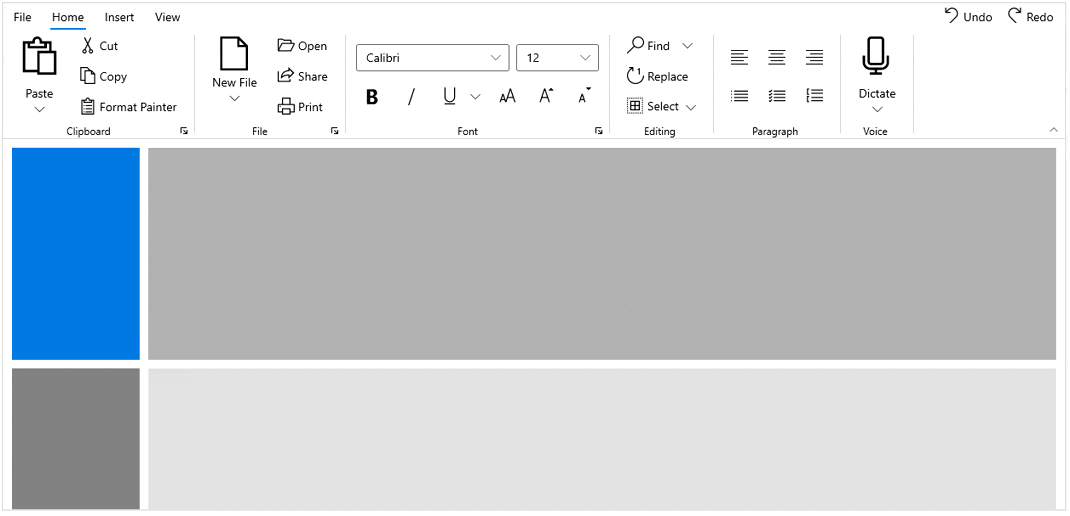
File menu (backstage button) visibility
Ribbon allows to show or hide a Backstage menu button using the ShowBackstageMenuButton property.
<ribbon:SfRibbon ShowBackstageMenuButton="False">
<ribbon:SfRibbon.Tabs>
<ribbon:RibbonTab Header="Home" />
<ribbon:RibbonTab Header="Insert" />
<ribbon:RibbonTab Header="View" />
</ribbon:SfRibbon.Tabs>
<ribbon:SfRibbon.Backstage>
<ribbon:RibbonBackstage>
<ribbon:BackstageView />
</ribbon:RibbonBackstage>
</ribbon:SfRibbon.Backstage>
</ribbon:SfRibbon>
File menu (Backstage button) text
The BackstageMenuButtonContent property allows to set a content of the Backstage menu button in the Ribbon. The content of the property is specified as File by default.
Backstage view
Ribbon provides the BackstageView as separate view like in Microsoft Outlook and Word applications, that can be hosted inside the Ribbon backstage. The backstage view contains tabs and buttons.Separators are placed between backstage view items to create groups and it can be added using Items property. The view can be placed at the top or bottom of the application.
<ribbon:SfRibbon>
<ribbon:SfRibbon.Tabs>
<ribbon:RibbonTab Header="Home" />
<ribbon:RibbonTab Header="Insert" />
<ribbon:RibbonTab Header="View" />
<ribbon:RibbonTab Header="Layout" />
</ribbon:SfRibbon.Tabs>
<ribbon:SfRibbon.Backstage>
<ribbon:RibbonBackstage>
<ribbon:BackstageView>
<ribbon:BackstageView.Items>
<ribbon:BackstageViewTabItem Header="New" />
<ribbon:BackstageViewTabItem Header="Open" />
<ribbon:BackstageViewItemSeparator />
<ribbon:BackstageViewTabItem Header="Info" />
<ribbon:BackstageViewButtonItem Header="Save" />
<ribbon:BackstageViewButtonItem Header="Close" />
</ribbon:BackstageView.Items>
</ribbon:BackstageView>
</ribbon:RibbonBackstage>
</ribbon:SfRibbon.Backstage>
</ribbon:SfRibbon>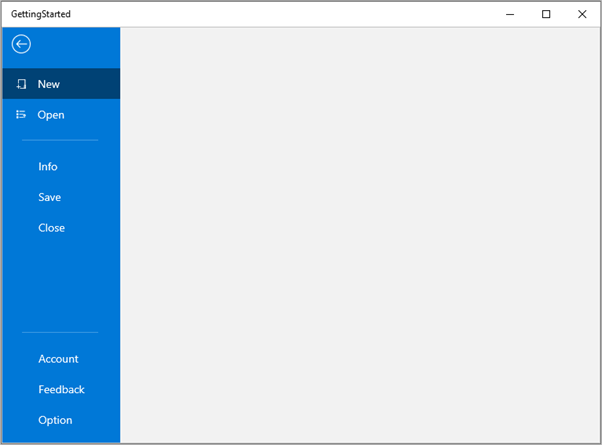
Backstage view visibility
The Ribbon allows to show or hide a backstage view visibility using the IsBackstageOpen property.
- Through property
The visibility of the backstage view can be directly enabled or disabled by setting value to the IsBackstageOpen property of Ribbon.
<ribbon:SfRibbon x:Name="ribbon"
IsBackstageOpen="True">
<ribbon:SfRibbon.Backstage>
<ribbon:RibbonBackstage>
<ribbon:BackstageView/>
</ribbon:RibbonBackstage>
</ribbon:SfRibbon.Backstage>
</ribbon:SfRibbon>- Through back button click event
The backstage view can be opened or closed dynamically using BackButtonClick event.
<ribbon:SfRibbon x:Name="ribbon">
<ribbon:SfRibbon.Backstage>
<ribbon:RibbonBackstage>
<ribbon:BackstageView x:Name="backstageview"
BackButtonClick="BackstageView_BackButtonClick">
</ribbon:BackstageView>
</ribbon:RibbonBackstage>
</ribbon:SfRibbon.Backstage>
</ribbon:SfRibbon>private void BackstageView_BackButtonClick(BackstageView sender, object args)
{
this.ribbon.IsBackstageOpen = false;
}- Through Back button command
The backstage view can be opened or closed dynamically using BackButtonCommand property.
<ribbon:SfRibbon x:Name="ribbon">
<ribbon:SfRibbon.Backstage>
<ribbon:RibbonBackstage>
<ribbon:BackstageView x:Name="backstageview"
BackButtonCommand="{x:Bind ButtonCommand}"
BackButtonCommandParameter="false" />
</ribbon:RibbonBackstage>
</ribbon:SfRibbon.Backstage>
</ribbon:SfRibbon>public ICommand ButtonCommand { get; set; }
this.ButtonCommand = new DelegateCommand(ExecuteButtonCommand, CanExecuteCommand);
private bool CanExecuteCommand(object obj)
{
return true;
}
private void ExecuteButtonCommand(object obj)
{
this.ribbon.IsBackstageOpen = bool.Parse(obj.ToString());
}Back button visibility
The BackstageView allows to show or hide the back button using ShowBackButton property.
<ribbon:SfRibbon x:Name="ribbon">
<ribbon:SfRibbon.Backstage>
<ribbon:RibbonBackstage>
<ribbon:BackstageView ShowBackButton="False" />
</ribbon:RibbonBackstage>
</ribbon:SfRibbon.Backstage>
</ribbon:SfRibbon>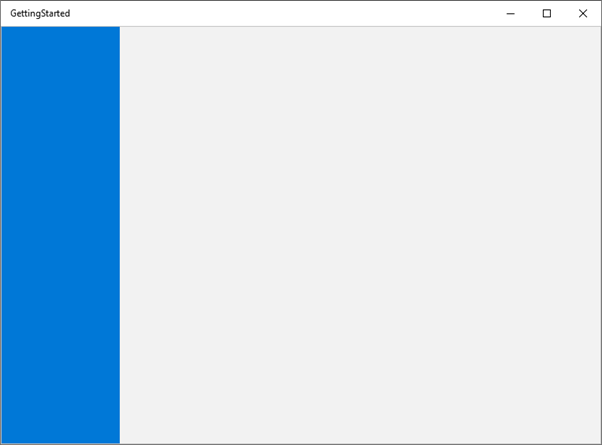
Backstage items
The backstage items such as BackstageViewTabItem, BackstageViewButtonItem and BackstageViewItemSeparator can be added to the top of the backstage view using the Items property.
Backstage tab item
The BackstageViewTabItem can be added to the backstage view and provides a separate view of the backstage while clicking the tab item. Use the Header property to provide a name to the tab.
<ribbon:SfRibbon>
<ribbon:SfRibbon.Backstage>
<ribbon:RibbonBackstage>
<ribbon:BackstageView>
<ribbon:BackstageView.Items>
<ribbon:BackstageViewTabItem Header="New" />
<ribbon:BackstageViewTabItem Header="Open" />
</ribbon:BackstageView.Items>
</ribbon:BackstageView>
</ribbon:RibbonBackstage>
</ribbon:SfRibbon.Backstage>
</ribbon:SfRibbon>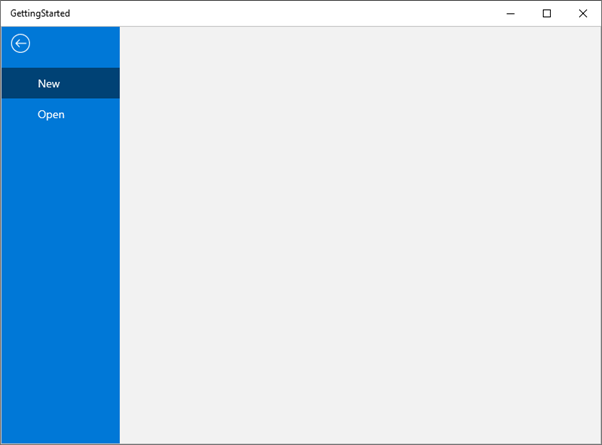
Backstage button item
The BackstageViewButtonItem can be added to the backstage view that performs the actions of the Click event. The Command can be used instead of Click Event, and the buttons with the name Save and Close are added using the Content property.
<ribbon:SfRibbon x:Name="ribbon">
<ribbon:SfRibbon.Backstage>
<ribbon:RibbonBackstage>
<ribbon:BackstageView>
<ribbon:BackstageView.Items>
<ribbon:BackstageViewButtonItem Header="Save" />
<ribbon:BackstageViewButtonItem Header="Close"
Click="BackstageViewButtonItem_Click" />
</ribbon:BackstageView.Items>
</ribbon:BackstageView>
</ribbon:RibbonBackstage>
</ribbon:SfRibbon.Backstage>
</ribbon:SfRibbon>private void BackstageViewButtonItem_Click(object sender, RoutedEventArgs e)
{
this.ribbon.IsBackstageOpen = false;
ContentDialog contentDialog1 = new ContentDialog();
contentDialog1.Title = "Backstage closed";
contentDialog1.PrimaryButtonText = "Close";
await contentDialog1.ShowAsync();
}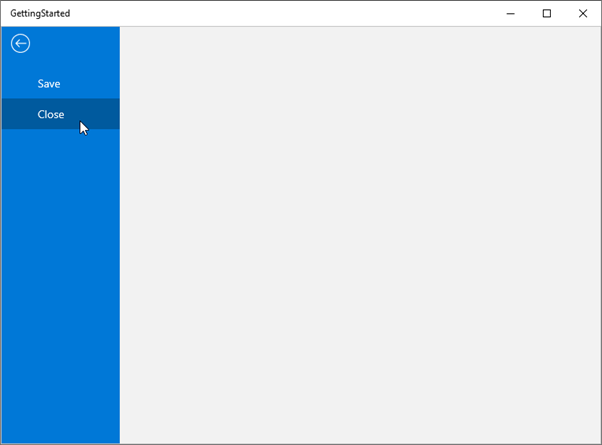
Backstage separator item
The BackstageViewItemSeparator displays a line used to separate the backstage view items such as tabs and buttons. The separator can be added to the backstage view by the following code snippet.
<ribbon:SfRibbon x:Name="ribbon">
<ribbon:SfRibbon.Backstage>
<ribbon:RibbonBackstage>
<ribbon:BackstageView>
<ribbon:BackstageView.Items>
<ribbon:BackstageViewTabItem Header="New" />
<ribbon:BackstageViewTabItem Header="Open" />
<ribbon:BackstageViewItemSeparator />
<ribbon:BackstageViewTabItem Header="Info" />
<ribbon:BackstageViewButtonItem Header="Save" />
<ribbon:BackstageViewButtonItem Header="Close" />
</ribbon:BackstageView.Items>
</ribbon:BackstageView>
</ribbon:RibbonBackstage>
</ribbon:SfRibbon.Backstage>
</ribbon:SfRibbon>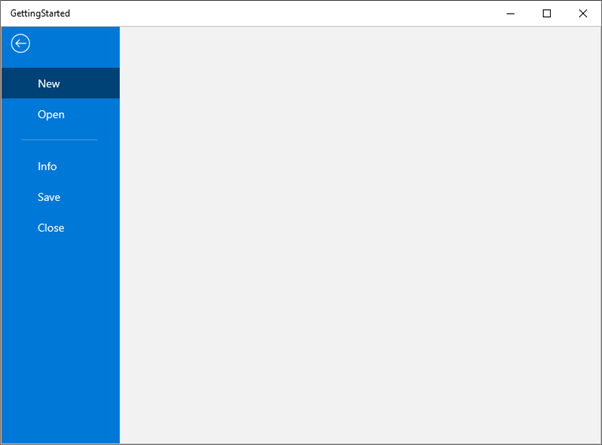
Footer items in backstage view
The BackstageView allows to add footer items using FooterItems property and the backstage items can be added to the footer of backstage view by the following code snippet.
<ribbon:SfRibbon x:Name="ribbon">
<ribbon:SfRibbon.Backstage>
<ribbon:RibbonBackstage>
<ribbon:BackstageView>
<ribbon:BackstageView.Items>
<ribbon:BackstageViewTabItem Header="New" />
<ribbon:BackstageViewTabItem Header="Open" />
</ribbon:BackstageView.Items>
<ribbon:BackstageView.FooterItems>
<ribbon:BackstageViewItemSeparator />
<ribbon:BackstageViewTabItem Header="Account" />
<ribbon:BackstageViewTabItem Header="Feedback" />
<ribbon:BackstageViewButtonItem Header="Option" />
</ribbon:BackstageView.FooterItems>
</ribbon:BackstageView>
</ribbon:RibbonBackstage>
</ribbon:SfRibbon.Backstage>
</ribbon:SfRibbon>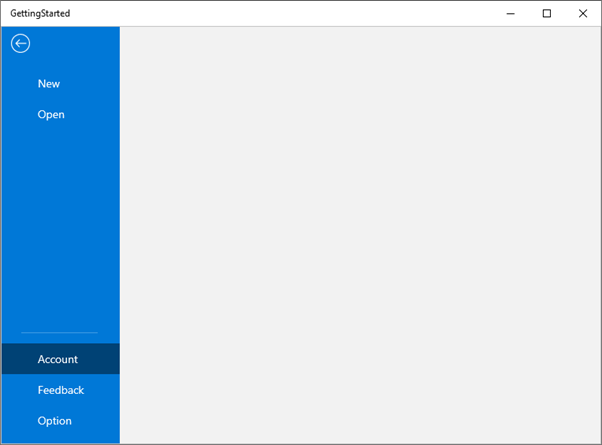
Icons for backstage view items
BackstageView items such as BackstageViewTabItem , BackstageViewButtonItem and the tabs can display an icon as graphical content using the Icon property
<ribbon:SfRibbon x:Name="ribbon">
<ribbon:SfRibbon.Backstage>
<ribbon:RibbonBackstage>
<ribbon:BackstageView>
<ribbon:BackstageView.Items>
<ribbon:BackstageViewTabItem Header="New"
Icon="NewFolder" />
<ribbon:BackstageViewTabItem Header="Open"
Icon="OpenWith" />
<ribbon:BackstageViewItemSeparator />
<ribbon:BackstageViewButtonItem Header="Save"
Icon="Save" />
<ribbon:BackstageViewButtonItem Header="Close"
Icon="Cancel" />
</ribbon:BackstageView.Items>
<ribbon:BackstageView.FooterItems>
<ribbon:BackstageViewItemSeparator />
<ribbon:BackstageViewTabItem Header="Account" />
<ribbon:BackstageViewTabItem Header="Feedback" />
<ribbon:BackstageViewButtonItem Header="Option" />
</ribbon:BackstageView.FooterItems>
</ribbon:BackstageView>
</ribbon:RibbonBackstage>
</ribbon:SfRibbon.Backstage>
</ribbon:SfRibbon>![]()
NOTE
The other icon types can also be used such as BitmapIcon, FontIcon, PathIcon and SymbolIcon to the backstage view items.